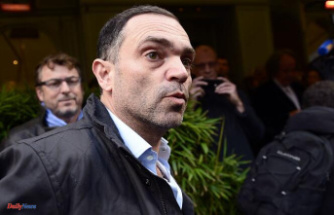An exhibition can be seen in Berlin until April that pays homage to vampirism, which received a phenomenal monument in Germany more than 100 years ago with the silent film "Nosferatu". According to earthly laws and the judgment of the judiciary of the time, the film shouldn't even exist.
Some people believe in vampires like children believe in Santa Claus. The following applies to them: They love the transition from day to night. They have fantasies of beings and worlds beyond rational earthly existence. They want to be part of the magic - if only through a lifestyle with parties, a certain decor and many rituals, which we can all experience again in these Christmas weeks. Anyone who wants to dismiss vampirism as a cultural trend or even as a quirky niche program in the light of the magnificent Christmas festival is not doing justice to the size and importance of the genre.
The assessment would be even more backwoods than anything "Transylvania" has to offer - that legendary region north of the Carpathians which is officially part of Romania and whose Latin name means "beyond the forest".
Transylvania is considered the home of vampires, which is why garlic hangs in guest rooms there or Bran Castle is advertised as the ancestral seat of Count Dracula - although there is no evidence of this. Almost a million visitors don't want to see the place of work of a historical figure who "once was", but rather a vampire prince who "still is". It is precisely this illusion of existence that is reminiscent of childhood projections onto Santa Claus.
Not only has a phenomenal lifestyle developed around the idea of undead bloodsuckers, but also a business that is extremely lucrative: book publishers, film producers and their authors earn a lot. More than 160 million copies of Stephenie Meyer's book series "Twilight" alone have been sold, while the film series of the same name has grossed more than 3 billion euros. In addition, there are more and more festivals in the "Gothic" category - and Halloween, the traditional All Saints' Day in the English-speaking world, wouldn't be the same without vampire costumes. In a frightening way, a kind of blood thirst increases - or at least is registered more frequently: Psychiatric clinics are reporting more and more people who drink other people's lifeblood!
On the way to today's vampire cult with its varieties and interpretations, a work should not go unmentioned that was created from start to finish in Germany - and that would never have been created if the Irishman Bram Stoker had not written the novel "Dracula" and published it in 1897. We are talking about the 1921 silent film "Nosferatu - A Symphony of Horror". Ironically, "Gray" was the name of its initiator, producer and - you have to call it that - bankrupt.
And right from the start, Albin Grau intended something big and extraordinary. The first reason for this was the choice of director Hans Wilhelm Murnau, who embodied the cinematic avant-garde of the time and was supposed to create a work with "Nosferatu" that the French Surrealists especially loved. The writer André Breton is even said to have described "Nosferatu" as a key surrealist work. It is this marginal note from the reception that has contributed to the fact that the exhibition "Phantoms of the Night. 100 Years of Nosferatu" has just opened in the Berlin Museum for Surreal Art, the Scharf-Gerstenberg Collection at Charlottenburg Palace.
There you can understand the history of the origin and impact of Nosferatu with numerous documents. This also includes the way in which Gray really thought completely differently - and foresaw the vampire boom to come. As a commercial artist, for example for the Tietz department store chain, he attached particular importance to promoting the film, which is why he placed advertisements with mysterious messages in newspapers and magazines months before the premiere in March 1922. All in all, the costs for the media fireworks should be greater than for the actual film. In the end, the public interest was as huge as the hole in the budget of the production company, which went broke over it.
Grau had hardly spared any effort for the film either: For the first time in film history, this included outdoor shots - in Transylvania, of course. Or trick effects that were completely new at the time, such as the sudden appearance or disappearance of the main character Nosferatu - who, to make matters worse, was played by a man whose real name was Max Schreck. His portrayal seemed so horrifying to people at the time that suspicions soon arose that Schreck himself was a vampire. A thesis, by the way, that became the subject of the film "Shadow of the Vampire" produced by Nicolas Cage in 2000: with John Malkovich as Murnau and Willem Dafoe as Max Schreck.
While the belief in vampires was hundreds of years old and part of folklore in different European regions, it was Stoker who, with Dracula, shaped the idea of an eccentric vampire prince that still dominates today. He lives on the border of our civilisation, cherishes fantasies of world domination and nurtures the deepest fears: of a so-called Antichrist, who will reverse the polarity of Western Christian civilization for his shadowy realm and ultimately destroy it. The blood loss of the human race as a primal fear of the devil.
The name "Nosferatu" is emblematic because it was thought by Stoker and other authors in the 19th century to be a Romanian word combining the meanings "vampire", "infidel" and even "devil". Although these assumptions are etymologically incorrect, the warnings stand.
They are reinforced by the name "Dracula", which Stoker had also misunderstood as a Romanian "devil". In fact, it means "son of the dragon" and refers to a true, extremely brutal ruler on Christian Europe's border with the Turks: Vlad III. "Draculea", whose father was called "Dracul", is said to have impaled enemies in rows and imprisoned and burned beggars in the 15th century.
If the evil in Stoker's novel was embodied by a kind of gentleman vampire, who was later lent his face by the Hungarian-born actor Bela Lugosi in the Hollywood film "Dracula" from 1931 and gave an exquisite aura with intellectual as well as (bi-)sexual attraction, Murnaus is Bloodsuckers a completely different type: He lacks the charisma to ever be allowed to enter a men's club. Nosferatu is gaunt, bald, and has long, pointed fingers. He hides his thirst for power and blood behind an apparently dehumanized facade.
The exhibition in Berlin reconstructs the role and Murnau's forms of representation in a darkened and at the same time very enlightening way. Like the protagonist in the film - the traveling salesman Thomas Hutter, who has to visit Nosferatu at his Transylvanian castle - one can step through a ghostly gate and grasp this as the moment of crossing the border, which is also expressed in the central sentence: "Hutter had hardly had the bridge exceeded, then he was seized by the uncanny visions of which he had often told me." On the other hand, you dive into the magic of an apparently existing nocturnal parallel world that vampire fans love to this day.
However, what the exhibition texts withhold like an eerie secret is the fact that, strictly speaking, Murnau's film shouldn't even exist! After all, Bram Stoker's widow had never approved of Grau's plans. The copyright dispute that developed from this led to the verdict in 1925 that all the strips had to be destroyed and were no longer allowed to be performed.
Today's digitally revised version was only possible thanks to the copies that were in the USA and France and to which the German judiciary had no access. It is also shown around the clock in Berlin. If you want free entry to the spectacle, you have to do what vampires do best: draw blood! The Red Cross helps with this.
The exhibition "Phantoms of the Night. 100 Years of Nosferatu" runs until April 23, 2023 in the Scharf-Gerstenberg Collection in Berlin. The Red Cross enables blood donations there once a month, next on December 21, 2:30 p.m. to 6 p.m.
(This article was first published on Sunday, December 18, 2022.)












